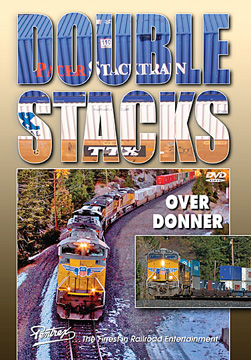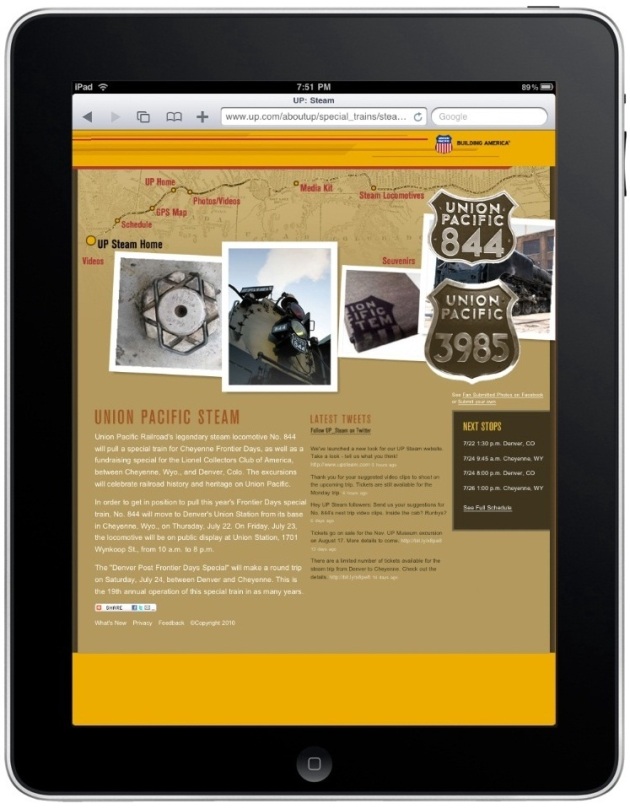The BNSF 4311 West Became Everyone's Bad Day
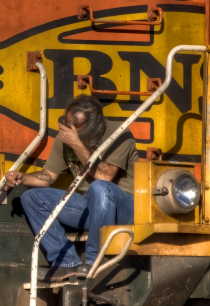 BNSF Engineer “Leonard” wipes his brow as we all wait.The radio crackled as an assertive and calm voice made a call for help, “Fort Worth Mechanical, this is BNSF forty-three eleven West.” (We later learned that the voice belonged to the BNSF engineer of a westbound manifest train. His name is Leonard.)
BNSF Engineer “Leonard” wipes his brow as we all wait.The radio crackled as an assertive and calm voice made a call for help, “Fort Worth Mechanical, this is BNSF forty-three eleven West.” (We later learned that the voice belonged to the BNSF engineer of a westbound manifest train. His name is Leonard.)
In short order the reply came in loud and clear, “Fort Worth Mechanical, go ahead BNSF forty-three eleven West.” (Fort Worth Mechanical is BNSF’s Mechanical Department which is based in Fort Worth, Texas and is a help-desk of sorts for the operating crews out on the rails.)
Leonard then proceeded to describe the predicament that he, his conductor, and their manifest train were in, some thirty-five miles west of the crew change point at Needles, California, “I keep getting a wheel-slip alarm on one of the units. If I go over 5 miles-per-hour then the alarm goes off.”
A short discourse between Leonard and the voice from Fort Worth Mechanical then ensued and it became clear that this is not going to be a good day — for neither Leonard or me. You see, I was out “chasing steel” on the Needles Subdivision and had just left Needles and was heading west looking forward to some heavy traffic levels that I have become accustomed to along the Needles Sub.
As we listened to the chatter between the Fort Worth Mechanical guy and Leonard we gleaned that the train was now stopped and the conductor, poor soul, was at the rear of the train to check things out. The temperature was hovering around 105 degrees, if I recall correctly, at that time. (It really doesn’t matter once it gets over 95 degrees anyways. It might as well be 120 degrees!) The conductor, John, reported that the Number 3 axle was frozen and that those two wheels were not turning on the single rear DPU which was BNSF #704. John also stated that it appeared that each wheel on that axle had a good size flat spot at the point where the wheel meets the rail. (This is akin to a flat tire in your car.)
As we rounded the bend west of the West Goffs control point, we could see a stopped train ahead. As we drove along the train and reached the head end my suspicions were correct in assuming that this was the now infamous BNSF 4311 West. I stopped the truck and took some photos.
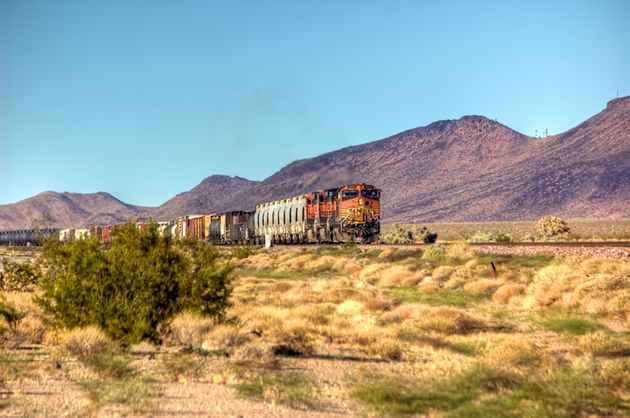 BNSF 4311 West is stopped west of West Goffs while the situation is assessed and a plan to correct the problem is devised.
BNSF 4311 West is stopped west of West Goffs while the situation is assessed and a plan to correct the problem is devised.
Since I was going to be driving back to the rear of the train, I carefully approached the lead unit and motioned for Leonard to open his window. I asked him if the conductor needed some water or anything since I was going to be driving to rear of the train. Leonard replied that John just radioed him and said he was fine because he had water and AC in the rear DPU. Off I drove to see the problem first hand.
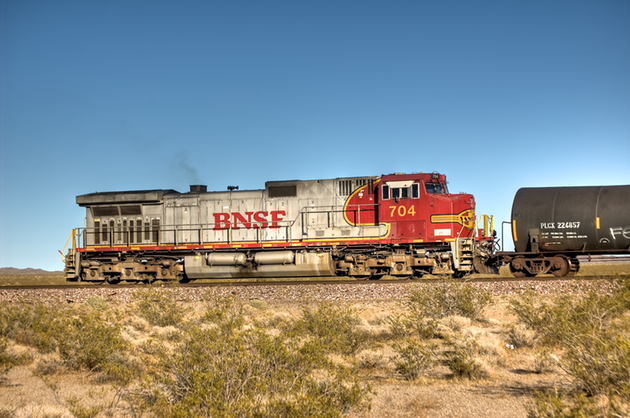 The offending unit, BNSF 704 holds the single rear DPU position with John holed up inside and, fortunately, out of the elements.
The offending unit, BNSF 704 holds the single rear DPU position with John holed up inside and, fortunately, out of the elements.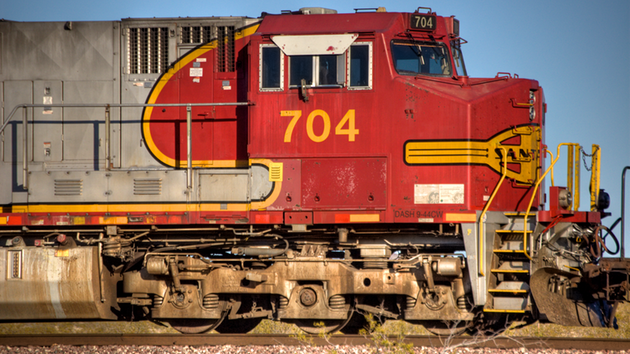 The axles are number from the front, so the number 3 axle would be the leftmost axle in this view.
The axles are number from the front, so the number 3 axle would be the leftmost axle in this view.
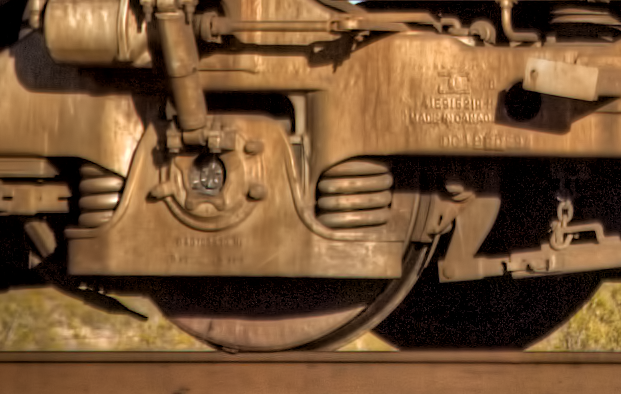 Here is a close-up view of the number 3 axle. You can see the melted steel glob that formed just behind the wheel on the left.At this point a plan was devised. The dispatcher had “dispatched” a helper set of locomotives to provide the train with enough power to get over Ash Hill once the axle was cut out or the unit was set out somewhere. Also, a railroad equivalent of the auto club tow truck for you car, a “responder” was dispatched from Needles to the scene. The responder is a member of the mechanical department for the BNSF and he has the knowledge and tools to fix most things, including frozen wheel sets or traction motors.
Here is a close-up view of the number 3 axle. You can see the melted steel glob that formed just behind the wheel on the left.At this point a plan was devised. The dispatcher had “dispatched” a helper set of locomotives to provide the train with enough power to get over Ash Hill once the axle was cut out or the unit was set out somewhere. Also, a railroad equivalent of the auto club tow truck for you car, a “responder” was dispatched from Needles to the scene. The responder is a member of the mechanical department for the BNSF and he has the knowledge and tools to fix most things, including frozen wheel sets or traction motors.
All of this was going to take time, not just to get to the location of the train but also to effect a resolution. As such, and the bane of my fears, the traffic on the line began to come to a standstill. A main element of any railroad’s transcontinental route is a carefully orchestrated dance of trains and crews to keep the shipments moving efficiently and effectively. With the BNSF 4311 West now occupying the normally westbound line it created a traffic jam for the dispatcher, whose job it is to keep things humming along. It is akin to one lane of a two-lane mountain road being unavailable — traffic will back up on both sides and it will take some time to recover the normal flow of traffic.
 Leonard performs the obligatory roll-by inspection of a passing train while waiting to get his train moving again.
Leonard performs the obligatory roll-by inspection of a passing train while waiting to get his train moving again.
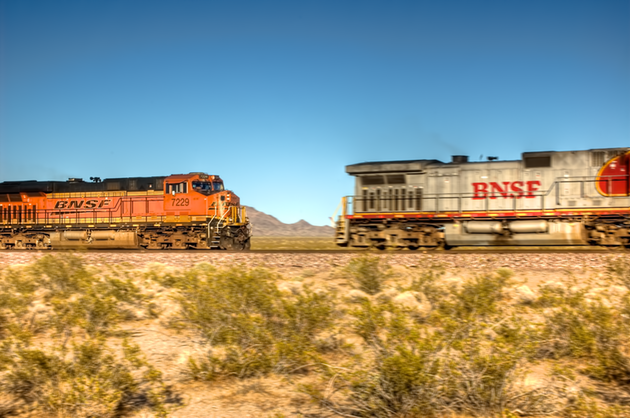 The first train behind the stuck 4311 is now run around the stalled train by way of the normally eastbound rail.After being dispatched out of the terminal at Needles, the responder eventually arrived on scene. He stopped at the head first and placed flags on the lead unit to signify that he was performing work on the train and that it is not to be moved at all. Only he can remove the flags.
The first train behind the stuck 4311 is now run around the stalled train by way of the normally eastbound rail.After being dispatched out of the terminal at Needles, the responder eventually arrived on scene. He stopped at the head first and placed flags on the lead unit to signify that he was performing work on the train and that it is not to be moved at all. Only he can remove the flags.
After flagging the head end and meeting with Leonard, the responder drove to the trouble spot, the rear DPU unit where John and us waited. When he reached the rear of the train John briefed him on the situation before them.
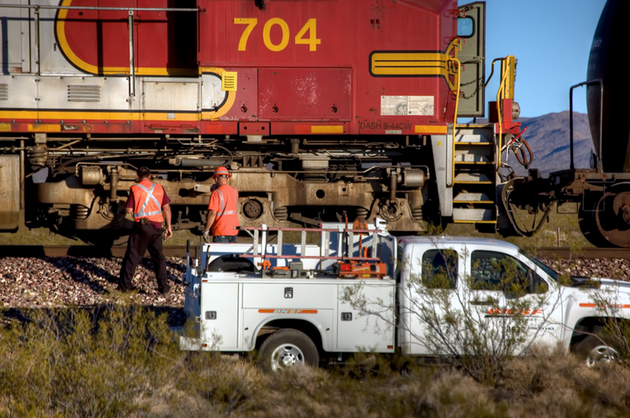 John, the train’s conductor (left), brief’s the “Responder” on the issue.
John, the train’s conductor (left), brief’s the “Responder” on the issue.
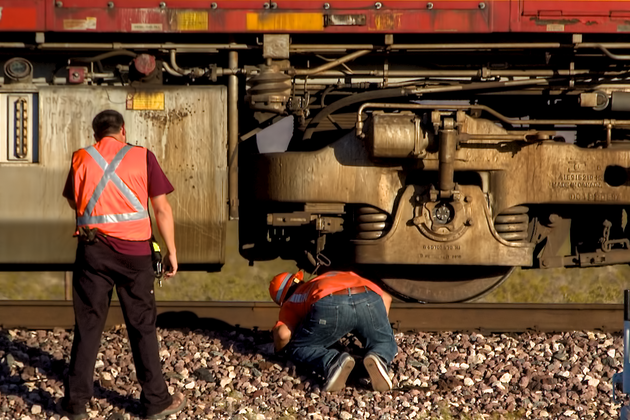 The responder takes a closer look. He is careful not to get too close yet since the other main line track is still in service at this point.
The responder takes a closer look. He is careful not to get too close yet since the other main line track is still in service at this point.
Once the responder has seen the problem first hand he positioned his vehicle closer to the train. However, before he could get to work and fix the frozen axle he wants the other main line closed so he is protected from possible injury by a passing train.
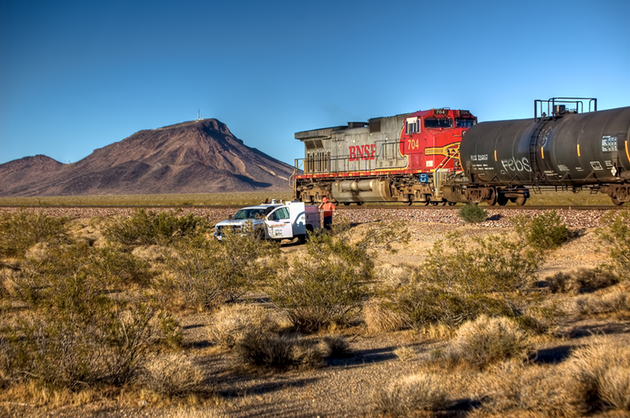 The responder flagged the rear unit as well and is now ready to work. Before he does though, he calls the dispatcher to get the main line trackage shut down for protection. As the process of closing the second main line down continued, he became apparent that this was going to take some time. The sun was setting and I wanted to get some shots in the “good light” of late afternoon so we decided to move on further down the line to see if we could capture some other cool scenes of railroading across the Mojave Desert.
The responder flagged the rear unit as well and is now ready to work. Before he does though, he calls the dispatcher to get the main line trackage shut down for protection. As the process of closing the second main line down continued, he became apparent that this was going to take some time. The sun was setting and I wanted to get some shots in the “good light” of late afternoon so we decided to move on further down the line to see if we could capture some other cool scenes of railroading across the Mojave Desert.
As we prepared to leave I approached John and the responder and wished them the best of luck. We headed west on Route 66. As we reached Leonard at the front of the train we stopped and wished him well also. With a blast from the train horn we drove off.
Unfortunately I didn’t learn the outcome of the stuck BNSF 4311 West. Perhaps someone who does will post a comment and let us all know.
As we reached the next control point west of the stalled 4311, CP Fenner, we took a shot of an eastbound intermodal stopped at the “all red” indications:
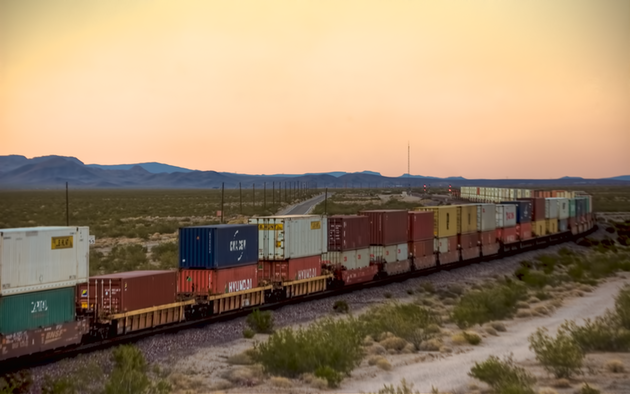 BNSF 7552 East is stopped at CP Fenner and waits, like us all, for the 4311 West’s problem to be remedied.One final shot was taken of the road home as we headed west:
BNSF 7552 East is stopped at CP Fenner and waits, like us all, for the 4311 West’s problem to be remedied.One final shot was taken of the road home as we headed west:
 The Road Home
The Road Home
 4311,
4311,  BNSF,
BNSF,  Leonard,
Leonard,  Needles Subdivision,
Needles Subdivision,  Responder CATEGORIES:
Responder CATEGORIES:  News,
News,  Railroad Photography,
Railroad Photography,  Ramblings and Such
Ramblings and Such 
